





















































































a wedding on the inpatient unit. It was a final wish for one of her patients and Jackie made it happen.
The nominators of the Gentle Beginnings Midwifery (GBM) team, Winchester Campus say working with them is a joy: “Their passion and compassion to their craft and to our community has been and continues to be bright light. Throughout the pandemic we have all had to learn and relearn how to do things. This group never fails to be positive, energetic, and understanding. The Family Birthing Department cherishes the strong working relationships they have with this group.”
submitted by Jane Adams, Communications Lead
“Jackie makes herself available to staff and does an excellent job supporting her students. She is a strong advocate for patient safety and staff well-being.”
“The Gentle Beginnings Midwifery group in Winchester provide passion, dedication, and support. Their willingness to collaborate, help us out in a pinch, teach, and learn is always so heartwarming and truly exemplifies

our commitment statement.”


The latest Commitment Award recipients are wellknown for their willingness to pitch in and to teach others. Congratulations to Registered Practice Nurse Jackie Imrie and the Gentle Beginnings Midwifery (GBM), Winchester Campus which includes Celine D’Arcy, Jennifer Pawlett, Melissa St Cyr, Elizabeth LeBlanc, Ashley Broadbent, and Deya Gauvin.
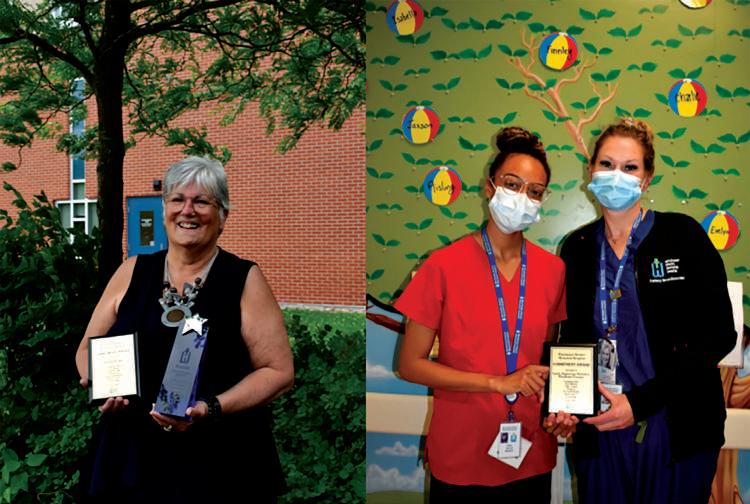
Jackie Imrie works on the Medical/Surgical Unit.
“Jackie is a role model for our staff and is the definition of compassionate nursing. Her commitment to WDMH is clear in her continued learning, training, and educating of students and new staff. She consistently advocates for excellent patient care, and has always been respectful to patients and fellow staff members throughout her many years of service at WDMH,” say her nominators. In fact, Jackie recently took the lead in organizing
The WDMH Commitment Award shines a light on individuals or teams that demonstrate the values that result in compassionate excellence.
Congratulations to all the nominees!

If you would like to provide comments or suggestions about hospital services, please contact Cholly Boland, President and CEO, WDMH at 613.774.1049 or by email at cboland@wdmh. on.ca.


ry is an organization called March for Our Lives, whose mission it is to end gun violence. “[Our] policy agenda is rooted in our community’s calls for safety, grounded in the perspectives of gun violence survivors and their families, and bolstered by robust policy analysis and conversation,” reads the organization’s website. “It interweaves the underlying forces we believe fuel gun violence – gun glorification, political apathy, poverty, armed supremacy and our country’s mental health crisis – and points to specific policy priorities for our movement.”
After the shooting in Uvalde, Texas, a march took place on June 11, with gun control advocates once again calling for positive action.
as learning to grow our own food, might ease the strains of keeping up and save time and money. Such ideas are all part of moving forward, and focusing on solutions, rather than problems.
by Brandon MayerLarry Pegg is a man with big ideas, big ambitions, a big heart, and a big desire to make the world a better place. The Osgoode resident expresses himself through songwriting, and tackles such issues as youth mental health, gun violence and school shootings, climate anxiety, and suicide prevention. Larry is a father of two daughters, one of whom tragically took her own life. He lives with guilt and many regrets every day, and wants to help create a better world.
After the Stoneman Douglas High School shooting of 2018, Larry wrote
a song called “American Sun”. The song speaks of an America infected with senseless loss and gun violence. “I curl into a ball and I cry,” Larry said, talking of the strong emotions he feels when thinking about school shootings. “And then I try to channel that into something positive, and that’s who I am.” Larry talked at length about the connections he has made, including teachers he has spoken with, and musicians he has worked with when channeling his emotions into songwriting. He continues to write music, describing himself as a “part time musician with a full time heart”.
A big inspiration for Lar-

Youth mental health is an important topic for Larry. He discussed COVID-19, and how it should be a priority to study the potential long term impacts of the pandemic on entire generations, given the large social impacts that it had on many children and youth. When asked about how the current economic situation, including the housing crisis and exorbitant fuel prices, could affect the mental health of young people, Larry had a unique perspective. “There’s a certain amount of detachment that we all must learn from the pressures and the fears,” he said. Larry believes that “keeping up with the Joneses” is a societal construction, and that living more simply, and sustainably, such

Local Member of Parliament Eric Duncan (StormontDundas-South Glengarry) is demanding the federal government immediately scrap the problem-ridden ArriveCan smartphone app process, along with the permanent removal of all federal travel restrictions and mandates.
“Our local constituency office has received countless calls and emails from constituents who are having horrendous experiences with the ArriveCan application,” said Duncan. “Seniors who don’t have smartphones or are not comfortable with technology are overwhelmed with the process, and many are just wanting to cross the border for lunch in Massena or to visit the Casino after two years of restrictions.” “Canadians have experienced various glitches when using ArriveCan and then receive
threatening messages of fines of $5,000 or more. It is absolutely ridiculous, and this daily chaos needs to stop immediately. The federal travel restrictions and the use of the ArriveCan app are unfairly and unnecessarily punishing Canadians who simply want to get back to their normal lives,” continued Duncan. It has been reported to Duncan’s office by numerous local residents returning to the country that children under five, who are exempt from testing and quarantine requirements, are being told to self-isolate upon their arrival at the border due to a glitch in the system. Those glitches have still not been resolved months later, and government officials have been continuing to advise families to create new email and ArriveCan accounts
each time they cross the border. “The tourism industry is finally hoping to see a recovery this summer travel season, but the federal government is standing in its way,” stated Duncan. “By doubling down on requiring the mandatory use of the ArriveCAN application, the Liberal government is actively discouraging travel to Canada.” Recently, a group of Canada-US border Mayors and tourism business leaders spoke out against the federal government refusals to scrap the Arrive Can app. In reaction to growing frustration at airport wait times and a drastic increase in cancelled flights, the federal government suspended the proof of vaccination requirements, while still requiring the ArriveCan app to be used at all ports of entry, including
When it comes to youth mental health, Larry believes that gaming culture could be an impediment to children getting help, as it draws in such addiction and hyper-focus that some youth simply can’t be persuaded to think about anything else. He also agrees with the idea that mental health help is simply too difficult for youth to access, unless they are dealing with very serious mental health issues. Larry doesn’t pretend to be a mental health expert, but he knows as well as anyone that mental health care is important and often lacking. “I am always thirsty to learn more,” he said. “I’m not an expert, other than… I’m in the club.” By “the club”, Larry was referring to bereaved parents.
Larry’s message that he hopes to get out to Canada and the world is that “the need is real”. This refers to the need to find solutions to guns and violence, the current mental health crisis, and other issues that threaten life and happiness. “We can’t let these issues fester in Canada the way we’ve seen them fester in the United States,” he said. “The issue of guns is a trigger point.”
More about March for Our Lives can be learned at https://marchforourlives. com/.
land borders. The federal government also announced that a paper ArriveCan form would be available as an option.


Duncan concluded by making the case for immediate changes. “The Liberals need to listen to these valid criticisms and acknowledge there is no need for ArriveCan to be mandatory to complete when returning to Canada, and with so many glitches and complaints, it needs to be scrapped. Canadians have been more than patient with the rules and restrictions during the pandemic. It’s time to make it easier to travel, end all federal mandates permanently, and let Canadians live their lives again without threats of charges and fears of being fined.”
(NC) Gardening is a favourite leisure activity for many of us, providing hours of relaxation, de-stressing and outdoor enjoyment. But if back pain, mobility issues or a health condition is getting in the way, don’t be discouraged. There are many things you can do to continue your hobby.
1. Start with a warmup
While it may not always feel like it, gardening is a physical activity, so just like any exercise it’s good practice to warm up before you start. A five-minute walk and some light stretches will help prime your body for extended periods of sitting and squatting. Be sure to consult your health care provider for warm-ups best suited to you.
2. Use the right tools
Simple things like cushions, kneelers and chairs can help you move and sit more comfortably and reduce the strain on your back and knees. Specialized tools like garden scooters and long-handled trowels and cultivators can help you when bending forward.
3. Check in with an expert
A health-care professional like an occupational therapist can assess your needs and help you develop strategies to adapt so you can continue doing the activities you love. They’ll work with you to find the right approaches to help you keep tending to your flower beds, plants and produce. You can find an OT through the College of Occupational Therapists. The College works to protect you and your family by ensuring all licensed OTs in Ontario are trained and qualified to offer safe, competent and ethical services. Find more information at coto.org.
You know how some birthdays or anniversaries seem to matter more than others? They’re usually the one with a zero at the end, like turning 30, or 50, or even 100. Or it could be marking 30 years in business, or fifty years married - those kind of things. Canada, for example, is 155 years old on July 1. I marked one of those anniversaries recently. On June 19, I was forty years in Canada. I arrived with a young family on that date in 1982, thinking I’d be here for a couple of years before going back to Ireland. Not that there was much to go back to in those days, which explained why I was here.
This may seem completely irrelevant to everyone else but me, though if I hadn’t arrived here 40 years ago, I wouldn’t be writing this now, and you wouldn’t be reading the Times either. It’s amazing how little decisions can have huge consequences you never would have expected. But, more to the point, thinking about 40 years in Canada also makes me realise how
much Canada has changed in those four decades. For better or for worse, this is not the country I arrived in as a young grad student at Lakehead University.
Some of the changes may not seem obvious at first sight. In 1982, the Prime Minister was called Trudeau, the same as now, and the Liberal Party was in power in Ottawa. But it’s not the same Trudeau and definitely not the same Liberal Party. As for the Opposition - definitely not your father’s Conservative Party. Comparing Joe Clark and Stephen Harper, for example, or even the unspeakable Pierre Poilievre, it is clear that much has changed in Canadian politics since 1982. And at the provincial level, what can you say? Remember when Premier Bill Davis, accused of being bland, gave the response: “In Ontario, bland works”. Would anyone ever accuse Doug Ford of being bland today?
Perhaps the biggest change in Canada has been the increasing domination of daily life by technology.
I wrote my thesis at Lakehead on an IBM Selectric
The Township of North Dundas wishes to remind all users of the Chesterville and Winchester Municipal Water System that in order to maintain an adequate supply of water, it is necessary to regulate the use of water for various property maintenance activities as follows:
For even-numbered municipal addresses, outside use of water is permitted on even-numbered calendar days.
For odd-numbered municipal addresses, outside use of water is permitted on odd-numbered calendar days.
Outside use of water is permitted between the hours of 5:00 - 9:00 am and 7:00 - 11:00 pm on your designated days, between the first day of May and the last day of September.
Upon the installation of a significant amount of new grass and/or sod or landscaping on a property, the outside use of water shall be permitted on said property for the newly installed grass and/or sod each day, during any part of the day, for a period of one week from the initial date of installation.
To help conserve water:
Use a rain barrel to collect rain water for your garden
Place mulch and bark around the base of trees and shrubs
Sweep driveways and patios instead of spray washing them
Repair leaky faucets and always turn off your taps tightly so they don’t drip
Typewriter, which was very hi-tech for its day: you could change the font by swapping out little metal spheres! A couple of years later, I was writing a dissertation on a university mainframe computer that took up a room and had less capacity than the laptop on which I’m writing this article. Now we all have smart phones, iPads, and even our cars talk to us! The Personal Computer, or desktop computer, seems old fashioned now, but was unimaginable, straight out of Star Trek miracle of the future in 1982.
Canada has changed in deep ways: the way Canadians see themselves and the place of Canada in the world is not what it was. How could it be, when we have social media on every platform reflecting a nasty, rude, racist and misogynist side of ourselves every hour of the day. The decency is still there, of course, and the generosity and community spirit; but we can no longer pretend to have a higher form of morality than others. Not that we ever did, but the harsh spotlight that has been thrown on Canada’s relationship with its
Indigenous peoples, its attitude to women, minorities, immigrants, all have caused some dramatic rethinking on our parts, as it should.
One of the features of the last couple of decades has been the number of times apologies were made by various Prime Ministers on our behalf for attitudes and events with deep historical roots. So many groups with valid historical grievances, aspects of our shared past that had to be admitted at last. When I first arrived here, I was able to go through two graduate programs in Canadian History at two separate universities, without having one single course in Indigenous history, or reading a single chapter in a book that dealt with that aspect of Canada’s past. That wouldn’t happen today.
And there we have the big positive: the lesson to be learned from the changes over forty years. Canada has had to face up to some pretty awful sins in its past, and not too far in the past either. Not everyone has accepted what has been found, and our society is far from a complete rehabilitation. But
the process continues, the coming to terms with things goes on, generation by generation, and there will be no going back now. I suppose that, in itself, may become a problem in the future. We are so determined to bring about necessary changes, that we may move too quickly. Laws have been changed in Canada over those 40 years that have altered the fabric of society in fundamental ways. But it’s not always clear how and why those changes were made, other than in a feverish attempt to right what were seen as wrongs. It may be we haven’t always considered the implications.
But Canada has shown itself open to change, to renewal, reassessments, to a rethink of what it means to be Canadian. The facts of the past have made that more
complicated and arduous than we might have expected, but we move ahead regardless. There is no end point for a country or a society, and 40 years is a short period in the life of a nation. The end is not yet, the process continues. But this personal anniversary has been a good time for me to look back and see how much has changed in Canada, and in me because of Canada. It still seems very strange for this working class kid from a Dublin suburb to be living the life I lead in this amazing country. Maybe I’m unsure of how it all happened. Maybe I’m surprised at how much this country has enabled me to grow and have an astonishing life. Maybe I’m amazed. Which reminds me: Happy 80th Paul, and thanks for all the music.
the north grenville TIMES

MELISSA OTTENHOF Marketing Consultant
Phone:613 329 0209
Email: melissa@ngtimes.ca www.ngtimes.ca

Have you ever wondered who are the individuals who strive to raise awareness about the benefits of patronizing local business to the consumer base in the township and regions beyond?
Wait no longer, here is your NDCC Board of Directors!
President: Nanda WubsHuizenga
Vice President: Loralee
Carruthers
Secretary/Webmaster: Jen Feeny
Treasurer: Sue Lanthier
Directors: Hayley Bedford & James Taylor
Township Representative: Gary Annable
The Chamber is always looking for new ideas to improve the business experience in North Dundas.
Send us your ideas, we are here to serve you!



gymnastic-like moves and balance.

It takes extreme dedication, training, and confidence. The horses are like no others, and coaches and clubs work together across the province, and country!
This is truly a spectacular sport and supportive community.
On June 18, Ontario celebrated by hosting their first provincial Vaulting Competition live since before the COVID-19 pandemic. Saturday's show was held at Nation Valley Ranch in Chesterville, home to Nation Valley Vaulters. There are 3 clubs in Ontario that are recognized by Vault Canada, from Listowel, Peterborough and Chesterville.
submitted by Nation Valley Ranch
North Dundas welcomed 52 vaulters from across Ontario this past weekend as part of a provincial vaulting show series.
Vaulting is an equestrian sport combined with gymnastics and dance. It is an FEI nationally recog-


nized sport, and part of the World Equestrian Games.
Unlike trick riding, where the focus is who can out stunt who the fastest, vaulting competitions include a judging panel where vaulters are judged on harmony with the horse, artistic interpretation, strength, choreographed freestyles,

There are folks who don't care for liver and some who just love it. Beth and I are fond of chicken livers and have them regularly. Though this is not a Cajun or Acadian recipe, we love Spaghetti Caruso, named after the late great tenor; apparently, this was his favourite dish. As usual, this is a simplified version so that you aren't standing in the kitchen all afternoon on a hot summer day. Don't be shy; give it a try!
Ingredients
-½ kilogram of chicken livers, cleaned and dredged in flour
-2 X 650 ml jars of prepared pasta sauce (use ones like garlic and onion)
·1 onion, chopped
·1 green pepper, chopped
·3 tablespoons of butter (salted or unsalted)

·1 cup of sliced fresh mushrooms
·1– 900 gram package of spaghetti noodles

·Parmesan cheese

Preparation
·Slowly heat up the pasta sauce in a good-sized saucepan to just below the boiling point


·In a separate pan, sauté the onion and green pepper then, the mushrooms
·Add the mixture to your pasta sauce

·Fold in the chicken livers and let them poach in the sauce
·Prepare the noodles to al dente and drain
Place a healthy amount of cooked noodles in a pasta bowl for each person. Cover with the sauce containing the chicken livers. Top with some parmesan cheese. Accompany with an Italian red wine, such as a Chianti (I recommend slight chilling). From start to finish, we are talking about a half hour time investment.
Best from pcormier@ranaprocess.com.


Nation Valley Vaulters can be seen performing at the RCMP Sunset ceremonies July 1 - 3 alongside the Musical Ride and The Capital Cowgirls Drill team!
Coach Jen Byvelds is even more excited to be taking five vaulters to the Nationals in Alberta at the end of the summer!




We’re all feeling it. Whether fueling up at the gas pump or making a trip to the grocery store, increasing costs of these basic goods have never been more apparent. Putting food on the table and fueling transportation, while recovering from a global pandemic, has created serious financial strain on all of us. But the price spikes don’t end there. On top of groceries and fuel, farmers are experiencing a major increase in the cost of input supplies. Not only is this increasing financial pressure on farm businesses, but also impacting stress levels and overall mental health for the farming community.
Inflation is impacting all aspects of our lives right now, and food is no exception. In fact, it has created a shock to the entire food supply chain and these impacts are being felt everywhere. The business of farming is one that is already financially and mentally straining in a normal year. With the added challenge of managing increased input costs, it has never been clearer that many farmers are pricetakers and are forced to pay what the market sets.
from fertilizer companies to farmers, who had to absorb that high cost, rather than passing it to the next stage of the supply chain.
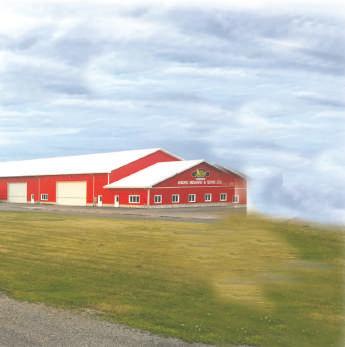
That is the average daily loss of farmland, according to data from the latest Census of Agriculture that was released last month. It is a steep climb from the 175 daily average loss that was recorded in the 2016 Census of Agriculture.
Servicing the grain industry since 1909



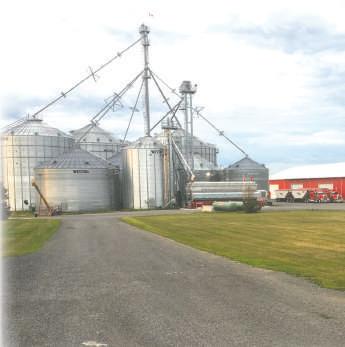


613-774-2720
Fax: 613-774-2921
The Ontario Federation of Agriculture (OFA) wants to reassure Ontarians that farmers are committed to bringing healthy and quality food to your table. Saying that, farmers are not responsible for increased prices at the grocery store and are facing their own rise in costs across the supply chain. A multitude of factors are contributing to inflated food prices, including an increase in employee wages, production costs, input supplies, and shipping and transportation costs. Costs to farmers are increasing just as they are for everybody else, and that undoubtedly has a ripple effect throughout the food supply chain.
Despite the additional financial strain, Ontario farmers continue to grow food, fuel and fibre with our best farm management practices.
Many farm products are sold as commodities or even in international markets. Many farmers are locked into contracts or have already committed to selling their products at a certain market price. Therefore, they cannot modify the cost of their farm product. While every day inputs like fuel and energy, feed and containers have risen in price, farmers cannot easily pass along the increases. Especially during the critical growing season, when we see increased use of tractors and harvesting equipment, farm business expenses continue to rise at unnatural rates.
It isn’t just about simple inflation, either. Geopolitical events are affecting the situation as well. Earlier this year, in response to the Russian invasion of Ukraine, Canada placed a 35% tariff on fertilizer imported from Russia and Belarus to deter Canadian support of these economies. However, some fertilizer suppliers had already purchased from Russia and could not avoid this tariff. Beyond farmers’ control, this price was passed
In addition to this global crisis, we are also experiencing the lagging impacts of the COVID-19 pandemic. In advanced economies, lower interest rates and government support programs increased consumer spending power. Simultaneously, as a demand for goods rose, a bottle neck in the world supply chain materialized as a demand for physical goods skyrocketed and factory and manufacturing closures prevailed. The imbalance between supply and demand led to a large increase in shipping costs which further raised the price of imported goods.
Interest rates that continue to climb alongside inflation has also significantly impacted financing costs of farm businesses putting further financial strain on farmers. It all adds up to a perfect storm, in a sense.


As Ontarians, there are ways to help. We know that you have choices of where to source your food. Ontario produce is lush and fresh and delicious. We know you have choices. We hope that you choose Ontario foods.
And to farmers across the province, we recognize the scale of economic instability and stress this puts on farmers and their families. Please remember that support is just a phone call away through the Farmer Wellness Initiative – 1-866-267-6255.
“To see a daily loss of 319 acres of farmland is a shocking jolt of reality that is simply not sustainable if we hope to have any kind of food sovereignty or independence in Ontario,” says Peggy Brekveld, President of the Ontario Federation of Agriculture. “While urban growth isn’t the only cause of farmland loss, it can’t be denied that development is putting intense pressure on Ontario farmland. Urban development is leap-frogging the Greenbelt and straining against urban-rural boundaries.”
Farmland is a finite, but diminishing resource, and the availability of prime agricultural land is fundamental to Ontario’s future. A country’s ability to feed its own population is an important pillar of a well-functioning and sustainable society.
But to do that, we need to ensure that we have land where we can grow our food, and in Ontario that space is limited. While the province is geographically large, much of the northern reaches cannot be farmed because of the Canadian Shield and climate. In the South, cities and towns cover much of the landscape. All told, only about five per cent of the province’s land is suitable for growing food or raising livestock.
Losing 319 acres of this land daily is the equivalent of losing nine family farms each week.
“What will that look like in 10, 50 or 100 years if left unchecked?” asks Brekveld. “Once this farmland is gone, it’s gone forever. We are not saying don’t build. We get the province has to accommodate growth. What we are saying is to build in the right places through long-term strategic landuse planning.”
The 319 acres per day figure was calculated based on a comparison of the total farm area in the province in the 2016 Census of Agriculture (12.4 million acres) versus the 2021 Census of Agriculture (11.7 million acres). The difference of 582,392 acres is divided by five to reach an average annual loss of 116,478.4 acres per year. Divide that by 365 days to 319.12 acres per day.
About Home Grown
A public awareness initiative of the Ontario Federation of Agriculture, Home Grown is a campaign to advocate for the importance of Ontario farms as a source of food, fuel and fibre. Arable farmland is the most important natural resource, but Ontario is losing an average of 175 acres of farmland to urban development every day; that is the equivalent of five family farms paved over every week. It is the objective of Home Grown to help develop a workable plan to guide responsible development in Ontario, ensuring growth to provide housing and support local tax bases while also protecting productive farmland.
Join the conversation on Twitter @OntarioFarms and Facebook /ontariofarms. For more information, please visit homegrown.ofa.on.ca.
A coupon which, when presented at A&W Winchester with the purchase of a Teen Burger, will result in a 50 cent donation to Winchester Dairyfest. Valid July 4 to August 7. Coupons cut out from the North Dundas Times will be honoured.

by Brandon Mayer
A unique idea will soon be put in motion to help fund one of Winchester’s most beloved local events. The new A&W franchise location in Winchester will have its Grand Opening on July 4, and from that point until the end of Dairyfest on August 7, the restaurant will host a fundraiser to help keep the festival alive.
The concept of the fundraiser is simple. Using a special coupon – which is appended to this article and can be cut out for use – the purchase of a Teen Burger at the Winchester A&W location will result in a donation of 50 cents to Winchester Dairyfest. While the fundraiser will help raise much needed funds
for the popular festival, the coupons also serve another purpose. “The idea is to create a buzz for Dairyfest in the community and getting our staff engaged in the community event,” said Kanwar Hazrah, owner of Winchester’s A&W franchise. “It wasn’t a difficult choice for us to promote Dairyfest. We are in the middle of a farming community, and we are in a dairy area. Dairyfest is one of the best organized festivals in the area where even the street light pillars and trees are painted with a cow face. We strongly believe in giving back to the community and participating in uplifting the community.”
Winchester Dairyfest has been a staple of the North Dundas community since it









Everyone should have a Wealth plan. Unfortunately, many individuals do not understand the importance of planning or what a comprehensive wealth plan can look like.
Anyone who has watched the news lately knows that the markets are volatile, interest rates and inflation are on the rise, and other economical and social uncertainties are prevalent. Many individuals are uncertain as to how these factors will impact their overall costs and standard of living.
To start, let’s look at a few key areas that Financial Advisors commonly look at when building a wealth plan for their client.
Your Advisor will help you determine the state of your current financial situation and discuss the goals and plans you have for the future. This could be anything from buying your first house to preparing for retirement.
Some key points to know when looking at your current financial situation are:
· your annual income
· your savings or investments
· your current fixed expenses or debt liabilities
Budgeting over the course of time can help an individual have a better understanding of what their monthly cashflow looks like. After having an accurate idea of an individual’s current situation, it is time to start the planning process. Some of the key areas are:
· Financial Management
· Emergency Funding
· Investment Planning
· Insurance and Risk Management

· Tax Planning
· Retirement and Estate Planning



After the creation of the wealth plan, it is important to remember it is not a one-time event. A wealth plan should be reviewed on an annual basis and when significant life events happen either expected or unexpected. Some examples are a change in marital status, the birth of a child, a change of employment etc.
was created as part of the town’s centennial celebrations in 1988. Like many community events, the festival did not run in 2020 or 2021. However, while many events were put on hiatus during these years because of the COVID-19 pandemic, Dairyfest would likely not have run in these years regardless. This is because the event is run entirely by volunteers donating their time, and there simply weren’t enough people willing to take on such responsibility.
In January of this year, the still-active Dairyfest committee came to a unanimous decision that 2022 would see the return of the festival. Community members were realizing that the loss of the festival meant the
loss of an important piece of community identity – one so important to Winchester that signs identifying the town as “Home of Dairyfest” are placed at the south and east entrances. It would appear that a threat to community identity was all the motivation needed to inspire proud North Dundas residents to pull up their socks, and revive Dairyfest.
In January, it was announced that this year’s festival would be smallerscale than in previous years due to predicted pandemic restrictions. However, with the pandemic now in its endemic phase, the planning may take a different direction. Winchester Dairyfest will run August 6 and 7.
When your Financial Advisor builds a wealth plan, it helps you to stay on track of your goals from a financial perspective. A sound plan will also give you piece of mind that when there is financial pressure, the strategies that were put in place will help you get past the challenging times.
If you are uncertain of where you are positioned to achieve your goals, it may be time to speak with your Financial Advisor.
We are always open to questions and giving people a second opinion when it comes to their Wealth plan. Feel free to get in touch with us at anytime.
We welcome questions so please reach out! See our ad in this week’s North Grenville Times and follow us on Facebook @OFarrellWealth.
Cole Seabrook is a Financial Advisor with Assante Capital Management Ltd. The opinions expressed are those of the author and not necessarily those of Assante Capital Management Ltd. Please contact him at 613.258.1997 or visit ofarrellwealth.com to discuss your circumstances prior to acting on the information above. Assante Capital Management Ltd. is a member of the Canadian Investor Protection Fund and the Investment Industry Regulatory Organization of Canada. Insurance products and services are provided through Assante Estate and Insurance Services Inc.
Phoebe or not Phoebe?
That is the question!
With the strange up and down weather we are experiencing at the moment, it is difficult to decide what to wear just stepping out into the garden! The birds seem to be coping with it, as they do, and are still in evidence wherever you care to look. Those who were nesting in my bird boxes are still around, even though their young have "flown" and are still busy searching for food for themselves, if no one else.
I witnessed, through our kitchen window, one of our Bluebirds, which seemed to appear out of no-where to "shoo off" a squirrel, on our deck fence! I am at a loss as to why that might have been, as they weren't anywhere near the former's nest, from which the young had already departed! On another day, working outside, a loud racket in the sky above my head drew my at-


tention from what I was doing. There was a Hawk being harangued by an irate Crow as it tried to fly by. They were both quite high up as the bigger bird tried to evade the continuous attacks on it, which were accompanied by hysterical "cawings"! I, foolishly, didn't fetch my camera to capture the occurrence, being so caught up in watching to see what was going to happen! Well, nothing seemed to be resolved and the pair of them disappeared from view,--still squabbling!
This morning I did have my camera to hand when I spotted a different bird shape flitting about near my nesting boxes, where our Wrens are still busy catching food. I thought, at first, that it was one of them that I was seeing, but the size difference drew my interest. My trusty zoom lens soon confirmed my suspicion and a picture of the bird and my bird book confirmed that it was, in fact, an Eastern Phoebe. It is a "Flycatcher', so hopefully it will be having a go at ridding us of some of those blasted mosquitoes, who seem to be relishing the damp warm weather! Hopefully it will soon settle down for us to enjoy the "outdoors" and some sort of a summer. Make sure that you don't miss it and stay safe and well. Enjoy! Cheers,
John BaldwinCommunity groups across the South Nation Watershed united throughout April and May to make the area where they live, work and play a little cleaner!
Through a partnership with the City of Ottawa’s Clean Up the Capital Initiative, Unsmoke Canada and the Findlay Creek and Greely Community Associations, South Nation Conservation (SNC) also helped provide free trees and shrubs to volunteers who helped clean up local communities and the Leitrim Wetland.
Clean-ups at High Falls Conservation Area in Casselman and the W.E. Burton Conservation Area in Russell were also highly successful, with many families coming out to help clean up their favourite community spaces.
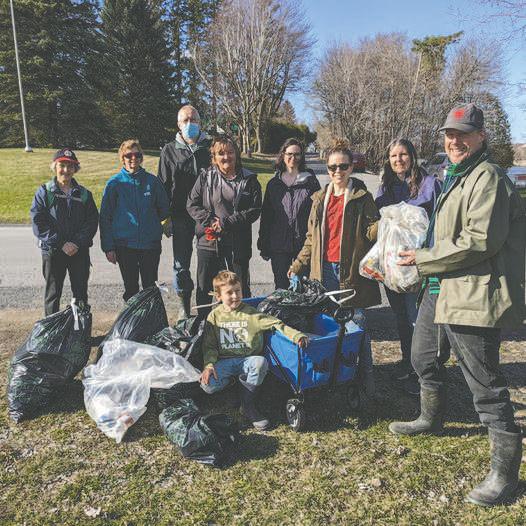
Clean-up activities
helped tackle waste that was revealed in the spring melt. Residents are encouraged to check social media and websites of their local community groups annually to participate in a nearby cleanup.
Funding for community clean-ups is available through SNC's Community Environmental Grants Program which has awarded over $50,000 to community groups and non-profit organizations since 2015. Applications are currently being accepted and funding is made available through partnerships with municipalities and SNC fundraising initiatives.
The Program has traditionally supported community events across SNC’s Eastern Ontario watershed jurisdiction that promote recreational use of rivers, protect the environment, or
celebrate natural heritage. Since the start of the Pandemic, the program has also supported public tree and shrub plantings and community gardens.
“We’re proud to support projects that the whole community can both learn and benefit from while protecting our local environment,” said Kelsey Smith, SNC’s Stewardship and Outreach Assistant. “Trees add infinite value to urban areas and community spaces, and people continue to visit municipal parks and Conservation Areas in record numbers, demonstrating the need for investments in these natural spaces.”
More information on SNC’s Community Environmental Grants Program can be found at www.nation. on.ca/grants, or by calling 1-877-984-2948.
$91,500 raised for local charities – including WDMH! submitted by Jane Adams, WDMH Foundation

A little break for the pandemic didn’t slow Shroomfest supporters down. In May, they came together again for an evening of fun and fundraising. The result? $91,500 was raised for 32 different community organizations, including $5,000 for the WDMH Foundation General Equipment Fund. We are so grateful!
The funds will be directed to the General Equipment Fund to support WDMH’s new electronic health record system, called Epic. It will change how patients are cared for –providing a simpler, more seamless journey through the hospital and the health care system.
Kyle Jones, Clinical & Education Lead for Epic Implementation, was on hand at the cheque presentation to share more details about one of the key benefits of the new systemSingle Sign-On: “The new secure software will allow clinicians to use a single tap of their name badge to sign in and out of multiple programs at the same time. They can move from location to location on different computers. Single Sign On saves providers valuable time so they can focus on patient care. Thank you for your generous support!”
Justine Plummer, Manager of Direct Mail & Events agrees. “We have such a supportive community, and we are so grateful to everyone who helped to make Shroomfest such as successful event!”
submitted by Jane Adams, WDMH Foundation
WDMH Foundation Board member and Ingleside resident Chris Chevalier had a plan –to raise funds and awareness for the WDMH Foundation. So she hosted a House & Garden Plant Sale in support of health care close to home. The event took place on May 21 and $195 was raised for the WDMH Foundation’s General Equipment Fund.
“As a Board member, I have learned that the provincial government does not fund medical equipment for WDMH. I have always supported the hospital, recognizing it as an excellent service provider,” notes Chris. “Special thanks to Sandy Casselman for all her help and to everyone who donated and purchased plants.”
“We are grateful to Chris and all the gardeners out there,” says Managing Director Kristen Casselman. “Community volunteers are the heartbeat of our Foundation, and we couldn’t do what we do without you!”
Chris Chevalier presents a cheque for $195

A year ago, Canada was thrown into shock and shame by media reports of 215 unmarked graves being discovered at an Indian Residential School [IRS] site at Kamloops, British Columbia. This story was followed by others from across the country reporting on other unmarked graves being discovered at other IRS sites. Canada Day was a very different event last year, as the nation tried to come to terms with what it was being told, and the government quickly introduced a new national holiday to commemorate the history of Indigenous people in Canada.
In the past few months, other media outlets have begun to cast doubt on the original claims made following the original Kamloops story, using headlines like: “How the world’s media got it wrong on residential school graves”. Suddenly there

was a deep division between those who sought justice for the dead children, and those who they called ‘denialists’, rather along the lines of Holocaust deniers. It was, and is, an extremely sensitive and emotional issue. If there is to be genuine reconciliation between the Indigenous peoples of Canada and the wider population, it has to be based on truth, on historical facts and research. So, what are the facts as we know them right now?
The Truth and Reconciliation Commission of Canada published a multi-volume report on their investigation into the IRS system in 2015, and one of the main findings was that, so far as they could judge, around 3,201 children had died throughout the era of the IRS, and that number might possibly go as high as over 4,200. No-one can, or should, deny the data, and the federal government has set up a Pathway to Healing fund of many millions of dollars to enable communities to investigate what may
have happened to the children from their community who attended an IRS. That work is continuing and will take some time to complete.
The situation is not as simple as many media outlets reported. The TRC statistics themselves, as they admit in their report, are not completely accurate, and the way the findings have been reported has been a product of lazy and unprofessional journalism. What is vitally important, if we are to have truth and reconciliation, is that the true story of each child is documented for each school: how many children died there? Why and how did they die? Where are they buried? More than anything, perhaps, we should find out who they were: not a statistic, not just a name, but a person, with a story, a family, an identity.
But that requires giving up knee jerk emotional responses to dramatic headlines that mislead. It also means giving up cynical revisionism that downplays
regions just north and south. Stingless bees are the source of a highly prized and distinct kind of honey that studies have shown to have antimicrobial, anti-inflammatory, and wound-healing properties.
the true picture of what happened to thousands of children. The truth often lies somewhere in the middle and it is never as simplistic as one side or the other make it. For example, the TRC report on the deaths of the 3,201 children did not find that they all died while attending a Residential school. According to the TRC findings, there is no clear record for where 1,391 of the children died. 832 children died at the schools, while another 418 died at home. The remainder died in hospital, or some other location. The vast majority died of diseases, particularly tuberculosis or some other lung issue. This was typical of the population as a whole, where TB, or Consumption, was a major killer of children until the late 1940's.
The revisionists point to the fact that no human remains have actually been found at any of the school sites, and that Ground Penetrating Radar cannot positively identify a grave. All
of the highly prized, natural antibiotic to meet local demand and to facilitate the emergence of an export market. The industry is small, but the promise for subsistence farmers to get a start in business is large.
of this may be true, but there are still more than 3,000 children buried in various locations around the country. The really damaging aspect of this is the casual misuse of terms in reporting the stories. The graves “discovered” were not new finds, they were known and recorded, but often unmarked. This was partly due to the fact that the original markers were plain wooden crosses that disappeared over time through weathering and other factors.
What is the proper focus now? Every single child who died, went missing, or is unaccounted for needs to be found. Records vary in scope for each school, but they can often be very useful in ascertaining when and where and why children died. For example, the 1918 Spanish Flu Pandemic was responsible for very many deaths in the country, in the schools, and in communities. No-one can deny that conditions in many schools were horrendous, that there
mously active chemical compounds produced by plants can hold significant therapeutic uses in diabetes and cancer treatments too.
was often not enough food or clothing for the children, that the Indian Department was criminally negligent in funding and supervising the entire IRS system. But we can’t simply generalise and condemn every school alike. The research being conducted now is necessary before any dependable picture emerges.
Using words like “murder”, or implying that unmarked graves were a secret attempt to cover up criminal activity is neither useful nor accurate. We owe it to all the children who attended the IRS system to find the truth of it all, in all its complex and tragic details. What has happened over the last year has not been helpful, has shown no respect to the real boys and girls who lived and died in those institutions. That should be our focus: honour the truth of their experience and then, maybe, we can work our way towards reconciliation.
tions the safety and side effects of pharmacological medicine, and takes reduction of waste, pollutants, and carbon emissions seriously.
The American poet Emily Dickinson understood the profound gifts of nature. She wrote, “The lovely flowers embarrass me, They make me regret I am not a bee –”
If bees could speak, they might add, “Let me do my work, so that you may live.”
Bees are vital pollinators, ensuring the success of a wide variety of the world’s most nutritious agricultural crops grown for human consumption.
Most people associate bees with painful stings and the tasty product of the Western honeybee. Being “busy as a bee” is a homage to the industrious nature of this pollinating
insect that collects nectar in a dozen or more foraging trips each day.
A small percentage of people who are stung by a bee or other insect quickly develop anaphylaxis, a potentially lifethreatening severe allergic reaction that demands emergency treatment.
But not all bees sting. Within a niche field of entomology, the study of insects, scientists are studying a special tribe of bee species called stingless bees.
They are fascinating members of the animal kingdom, found in the countries located between the Tropics of Cancer and Capricorn, as well as the
Said to be the “Mother Medicine”, the matured nectar produced by native stingless bees includes chemicals that ward off microbial and fungal growth, an adaptation to keep the substance from spoiling in the tropics. Given the wide variety of plant biodiversity in the Amazon, and the incredible range of botanical chemicals the bees mix into their honey, it’s also no surprise it has medicinal value. The propolis, or gluey resinous mixture they use to seal their hives, is also prized.
Dr. Kathrin Krausa is a visiting scientist at the International Centre of Insect Physiology and Ecology. She and beekeeper Warren Steyn know where these special bee species can be found. Local beekeepers in Tanzania have successfully established thousands of colonies on the forested slopes of Mt Kilimanjaro and Mt Meru. That amounts to millions of bees producing enough
Said to be the “Mother Medicine”, the honey produced by stringless bees leverages nature’s remarkable biodiversity. “The matured nectar produced by native stingless bees includes chemicals that ward off microbial and fungal growth,” Krausa says.
Steyn appreciates the amount of delicate labour involved in the harvest. “Western honeybees will keep Winnie-the-Pooh stocked with pots of the gooey sweetness,” he says. “Stingless bee honey is better consumed by the teaspoon, as part of a natural health regimen.”
African communities have long known the medicinal properties of stingless bee honey. “They keep colonies as a first aid boxes next to their houses,” Steyn says.

But what’s so important about the biological qualities of a rare honey for people a world away? The emerging scientific literature on stingless bee honey offers evidence that the presence of enor-
Natural approaches are a good first line of defence against the development and treatment of disease. This outlook is paramount in sustaining a world that values biodiversity, ques-
Sign-up at www.docgiff.com to receive our weekly e-newsletter. For comments, contact-us@ docgiff.com. Follow us on Instagram @docgiff and @diana_gifford_jones

Become an exhibitor at the largest event of its kind in North America, the 103rd International Plowing Match & Rural Expo. Expected over 75 000+ visitors, the IPM can provide great opportunities for companies and organizations to showcase their products and services.
They are looking forward to welcoming exhibitors to IPM 2022 in North Grenville, United Counties of Leeds & Grenville!
FOR SALE
Old horse machinery for lawn ornament or for use. No 1 horse hay. Call Jim 613-258-3561
Travel trailer Jaco, 5th wheel, fully loaded, 28ft long, perfect condition. Must sell. Call Jim 613258-35612
Brand New Wedding
Dresses, never been worn, Tags Still On, LULUS (XL) ordered online. $300 each (phone number: 613-203-2724
Men's bicycle, 2 electric motors, jointer planer. Call Doug 613-258-4573
No. 6/4 wire cabtire 18 meters; No, 6/4 wire liquidtight 15 meters; $175.00 each or both for $300.00. Bill 613-8501584
Two brand new wedding dresses, tags still attached, bought online LULUS (XL) $300 each
1992 Ford Econoline E150 Palm Spring's edition. B.C. vehicle, no rust, 396000 kms. 5.7 litre engine, tested and certi ed $2500. Phone: 613-791-0204
Hearing aid with charger, hardly used. Call 613-5678533
Floating dock on the Rideau. 60' (3 sections and walkout) Best o er 613-258-8000
Firewood for sale $110 a cord delivered, min 2 cord for delivery. Call Jon 613-227-3650
Hay and straw for sale
4x4 round bales, stored inside. Call Jon 613-2273650
What an amazing day at the Tractor Jam on June 12th!
The organizers couldn't have done a better job!
The Antique Displays...The Beautiful Grounds...The Wonderful Auction Items...The Tractor Pull...The Music...
Everything was just great fun! Best of all...You...The People...Thank You!
We cannot believe the support we have received ever since December 26th when an electrical fire destroyed our repair shop. Thank You all for Everything!!
The Skuce Repairs Family
SERVICES
SERVICES
RETIRED CARPENTER
Renovations, kitchens, bathrooms, additions, decks, home repair.
Call George at 613 462 7637
HANDYMAN SERVICES
Call Bill 613 774 2922
Hedge Trimming
Small or Tall
Call Rob 613-795-1845'
Cedar posts and rails for sale, various sizes available. Call Jon 613-2273650
Looking to rent farmland for cash crops. Call or text Mitch @ 613-262-1204
HELP WANTED
Occasional muscle required part time for landscaping and waterfront maintenance on Boyd Landing , Merrickville. Heavy work. Pays $100 for five-hour day. Must have transportation. Phone 613 2847780.
GENERAL LABOURER NEEDED FOR CONSTRUCTION COMPANY TO START IMMEDIATELY. $18-$22/HR DEPENDING ON EXPERIENCE HARVEY (613)227-8850ETHEL (613)227-1945
W ANT3D
The Eric Gutknecht Memorial Bursary Charity is seeking 250ml jars (new or used) for 2022 jam/jelly sales.
Drop off at 529 George
Wills - Probate - Estates Estate Litigation

As heard on CFRA Experts on Call www.ontario-probate.ca









The United Counties of Stormont, Dundas and Glengarry (SDG), comments on the Province’s Draft Transportation Plan for Eastern Ontario


Dear Minister Mulroney:
It was very nice meeting you again several weeks ago in Prescott-Russell when the provincial plan to increase highway capacity in the National Capital region was unveiled. I hope you will recall that we met at the AMO conference in Ottawa in 2019 when I was part of our County delegation to discuss the expansion plans for Highway 138. Unfortunately, since that time, the province has taken no action to improve the safety of Highway 138, and the death toll continues to mount. That is why I am writing to you today.
The United Counties of SDG has had the opportunity to review and consider the Draft Transportation Plan for Eastern Ontario. While SDG Council supports many of the actions contained within this Plan, our Council was extremely disappointed to note that improvements to Highway 138 were not identified as a provincial priority, particularly given that this project aligns well with the Plans overarching goals of Connecting People and Places, Improving Safety, and Preparing for the Future.
Highway 138 is a crucial north-south commuter link through our County and region, connecting many of our communities (and the United States via the Seaway International Bridge) with the City of Ottawa. There is no other word to describe Highway 138 other than dangerous, due to the frequency and severity of motor vehicle collisions, the most recent fatality occurring only one week after release of the Plan. For decades, SDG, its local municipalities and the City of Cornwall have lobbied the province to make Highway 138 safer, and residents of our region continue to petition for action (https://www.change.org/p/make-highway-138-safer) In fact, our County CAO has attended at least 5 delegations with various Ministers of Transportation over the past 10 years, including you.
As your office is aware, in 2017, the Ministry of Transportation completed the Preliminary Design and Class Environmental Assessment Study for Highway 138 between Highway 401 and Highway 417. Through this report, the following improvements have been recommended to be implemented within the short to medium term:
- Construction of carpooling lots (completed in fall 2019)
- Intersection improvements at County Road 44
- Intersection improvements at County Road 18
- Construction of passing lanes at various locations, and


- Other intersection and traffic safety improvements.
The recommended improvements noted above are significant in scope and value and were positively endorsed by our community. SDG is confident that when these improvements are all implemented, they will positively improve the safety along Highway 138.
Respectfully, I cannot overemphasize the need to commence construction of passing lanes as soon as possible. Over the years, too many people have lost their lives or been seriously injured for the province to continue to ignore our requests. If you are not familiar with the grim statistics related to Highway No. 138, I encourage you to take a look. These statistics are widely available, either through the East Region OPP, Ministry staff, or open sources.
In light of the above, I request a meeting with you as soon as possible so concrete steps can be determined to move forward to make Highway 138 safer. Action is required now.
Sincerely,
Carma Williams, WardenSubmitted by Aleta Karstad
I had been suffering for a couple of weeks from back aches - figured I was just getting old. Then I felt slightly feverish for a few days, and went for a PCR test - Negative. Then the fever got serious. Son-in-law Rory took me to the Ottawa General on Sunday, June 12, with a rising fever that Tylenol was failing to control. Once I was checked and tested and everything else ruled out, the Emerg doctor began to wonder if it could be a tropical disease.
I hadn’t been traveling. Then he guessed that it was likely Anaplasmosis - so I was tested for tickborne Rickettsial diseases and sent home with a prescription for two weeks of Doxycycline which would knock out any of them.
The Doxycycline worked within 7 hours, as he had predicted, to stop the steadily rising fever in its tracks! The results came in on Monday, the next day: Serology: Borrelia
(Lyme) NEG


Serology: Erlichia NEG
Blood smear: Anaplasmosis POSITIVE

I returned home on June 19 after convalescing for a week at our daughter’s place in Kemptville, feeling normal and VERY lucky!
The scary thing is that I had not been aware of any tick bite this spring. Must
been one of the tiniest ticks, and didn't stay on! Not only is Anaplasmosis more dangerous than Lyme, it can be transmitted right away - as soon as the tick bites!
Fred has had four embedded ticks this springtwo Dog Ticks, and two of the Lyme-carrying BlackLegged Ticks. For the first one, he went to Emergency in Kemptville for a dose of Doxycycline. But we’d found none on me….
If I’d known I had a tick, I’d have gone to Emerg in Kemptville for a dose of Doxycycline, early on. In fact, I was there on Saturday, June 12, complaining of fever - but without information about a tick bite, and no rash, they figured I must have a blood infection, gave me a broad-spectrum IV antibiotic and sent me home with a prescription for Amoxy-Clav.

I find myself wondering how many of the “negative” tests for Lyme are really Anaplasmosis. It causes kidney and liver damage if not treated early, and is very dangerous “for the elderly and those
with underlying conditions”. Check. Check.
The late stage symptoms match those of COVID - respiratory failure, etc.
I’m glad to be alive and

well, instead of in the ICU, or dead!
Watch out, everyone!
Anaplasmosis is hereuse insect repellants (best is Piactive, from Canadian Tire. Lasts for 12 hours and is safe for kids and pets) and get yourself some "No Fly Zone" pants from Marks Work Wearhouse, impregnated with Permethrin, and lined for safe wearing. I have always worn skirts, everywhere except in a kayak. But now every day until the snow flies, I'lI wear my tick pants, even around the yard - with lemongrass spray on my ankles and feet. Not taking any chances.


33 years of successes.
After 11 years in the position, today Simpson announced his retirement from the County effective the end of 2022. Simpson’s career has included stops as a Planner with the former Township of Charlottenburgh, planning and administrative roles with the Town of Renfrew as well as CAO in Lanark Highlands and Town of Perth.
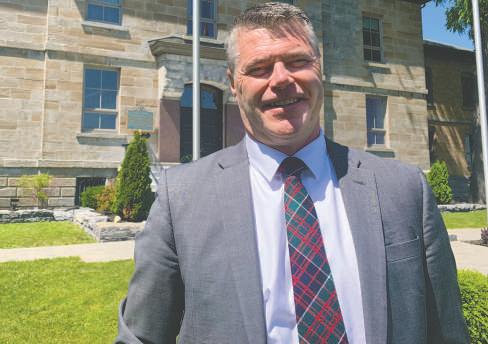
“With an election in several months and a new term of Council to be sworn-in in December, I’ve decided that now is the right time to step aside and move on from full-time work. Having more time will allow me to pursue the many activities I enjoy outside of full-time work.”
In 1990 the Edmonton Oilers were the Stanley Cup champions, gasoline cost less than 60 cents
a litre and Tim Simpson was beginning a career in municipal government that would wind its way through


“Deciding to retire from a position you enjoy and worked hard to achieve is very difficult,” Simpson said.


As Canada reaches the grand age of 155, it is a good time to look back and see how it all came to pass. As with so many things in Canadian History, the presence and threat of the neighbour to the south was a major factor in bringing the British North American Provinces together to form a new nation.
Confederation of the British North American provinces was not simply an idea in the minds of the politicians of the Province of Canada as the 1860’s dawned. Although the concept had been talked about on and off for a few decades by then, it had never been really pursued seriously. But as a political stalemate took an increasing hold on Canada, relations with the Republic to the south also gained in urgency and importance, and would have a profound influence on the story of Confederation.
From the time when European powers first made claims on North America, there had been a north-south struggle between them. At first, it was France north of the Saint Lawrence facing the Dutch to the south. Then the British took the place of the Dutch and the trading and military rivalry between the two Crowns finally resulted in the conquest of the French territory in 1760. The irony, of course, is that, just twenty years later, the British had lost the Thirteen Colonies and now they were the ones looking south at the noisy neighbours in some alarm.
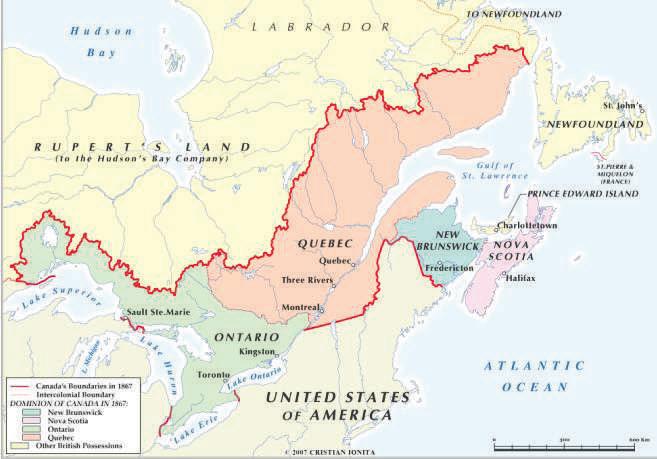
Twenty years after that, the two were at war again, as the struggle against Napoleon indirectly spilled over in the War of 1812. The Rideau Canal was built in the late 1820’s to provide a safe passage for troops and
material in case of another war with the United States. In 1838, Hunters Lodge “patriots” launched an attack at Prescott, using American territory as a base against the British Americans.
The growing economic strength, increase in population, and apparent intention of the Americans to expand across the continent, raised fears within the British Government in London that their North American colonies, particularly Canada, would be the cause of yet another war with the States. The mid-Nineteenth Century in Britain was a time of retrenchment, as the Government sought to cut expenditures and lessen their defense commitments in North America. Canadians, as well as the governments in the other British American provinces, were being urged to take on more responsibility for raising and equipping militia for their own defense, rather than relying on British regular troops.
Canadians, in particular, resisted those pressures from the Mother Country, believing that any conflict with the U. S. would come, not out of any dispute with them, but as part of a general confrontation between the Americans and the British Empire. Given that, they said, why should Canadians pay for a war the British would start? Sources of conflict certainly existed between the two nations, specifically over the borderline between Maine and New Brunswick, and Quebec and New Hampshire, disputes only ended in 1842 by the Treaty of Washington.
The shadow of the United States hung over British America, prompting both the local and the Imperial Governments to consider their options. The Imperial government became convinced
Simpson leaves behind a legacy of professionalism, efficiency, and modernization, said Warden Carma Williams.
“On behalf of Counties Council we salute Tim for his dedication to the United
Counties of SDG and the residents who call our beautiful region home,” said Williams. “Tim has a reputation for hard work, loyalty, and for this in-depth understanding of municipal operations. This is evidenced by his hard work on recent projects like the Counties’ focus on rural education. We wish Tim and his wife Shona all the best as they enter this new chapter.”
Simpson said his 11 years as CAO of the United Counties of SDG marks the highlight of his career in municipal government.
“One of the things that continues to inspire me is having an important role in the development and implementation of policies and programs that directly impact the daily lives of our residents,” he said. “County staff, both current and former, have worked handin-hand with me over the years and I wish to extend to them my heartfelt thanks and respect.”
County Council is currently considering its options with respect to filling the role.
that they would inevitably be dragged into a war with the U.S. as long as they were so committed to their colonies and especially the defense of Canada. The British Americans, again particularly the Canadians, were well aware of this attitude on the part of the Mother of Parliaments, and began to see the union of British America as the only safeguard against American expansionism. The Americans, for their part, had a strong sense of what they called Manifest Destiny, that is, that they were destined to take over the entire continent, coast to coast.
North and west of Canada were the Hudson’s Bay Company lands, stretching from west of Lake Superior as far as the Rockies, and north to Hudson’s Bay. This consisted of what is today northern Québec and Labrador, northern and western Ontario, all of Manitoba, most of Saskatchewan, south and central Alberta, parts of the Northwest Territories and Nunavut, and small sections of the United States. Both Americans and Upper Canadians cast longing eyes at the vast tract, and it was clear one of the two would move in at some point. 1861 was the year when these issues came together with the deep political problems facing the Canadian Assembly to create the impetus to get people willing to consider new arrangements, new ideas. The 1861 Census revealed that Upper Canada was now under-represented in the Assembly, but Lower Canada was unwilling to adopt Representation by Population. George Brown, firm advocate of Rep by Pop, was determined to win “Justice for Upper Canada”.
But it was the noisy neighbours who really put the cat among the pigeons. In April, 1861, the Federal
forces fired on Fort Sumter and the American Civil War began. Things were about to get very dangerous indeed for the province of Canada.
Overcoming provincial interests was not easy, and it would take years of talks, men of vision, and the threat of American annexation,
or even invasion, to finally bring about the Dominion of Canada in 1867.